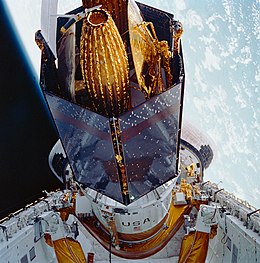 TDRS-C aboard Discovery | |
| Mission type | Communication |
|---|---|
| Operator | NASA |
| COSPAR ID | 1988-091B |
| SATCAT no. | 19548 [1] |
| Mission duration | Planned: 10 years Elapsed: 36 years, 3 months, 20 days |
| Spacecraft properties | |
| Bus | TDRS |
| Manufacturer | TRW |
| Launch mass | 2,224.9 kg (4,905 lb)[2] |
| Dimensions | 17.3 × 14.2 m (57 × 47 ft)[2] |
| Power | 1700 watts[2] |
| Start of mission | |
| Launch date | 29 September 1988, 15:37:00 UTC |
| Rocket | Space Shuttle Discovery STS-26 / IUS |
| Launch site | Kennedy Space Center LC-39B |
| Contractor | Rockwell International |
| Orbital parameters | |
| Reference system | Geocentric orbit |
| Regime | Geostationary orbit |
| Longitude | 151° West (1988) 171° West (1988–1990) 174° West (1990–1991) 62° West (1991–1994) 171° West (1994–1995) 85° East (1995–2009) 49° West (2009–) |
| Epoch | 29 September 1988 [3] |
TDRS-3, known before launch as TDRS-C, is an American communications satellite, of first generation, which is operated by NASA as part of the Tracking and Data Relay Satellite System. It was constructed by TRW, and is based on a custom satellite bus which was used for all seven first generation TDRS satellites.[4]
- ^ McDowell, Jonathan. "SATCAT". Jonathan's Space Pages. Retrieved 18 March 2014.
- ^ a b c "Tracking and Data Relay Satellite (TDRS) Characteristics". NASA. 10 September 2014. Retrieved 28 July 2020.
- ^ "NASA – NSSDCA – Spacecraft – Trajectory Details". nssdc.gsfc.nasa.gov. Retrieved 2 May 2018.
 This article incorporates text from this source, which is in the public domain.
This article incorporates text from this source, which is in the public domain.
- ^ Krebs, Gunter. "TDRS 1, 2, 3, 4, 5, 6". Gunter's Space Page. Retrieved 8 August 2009.
